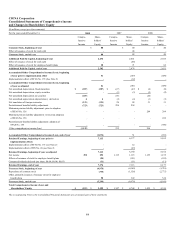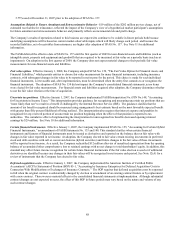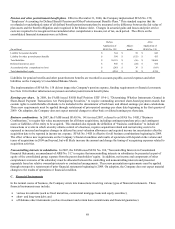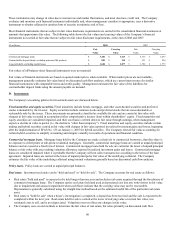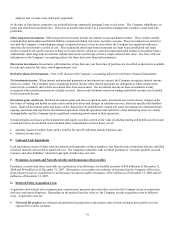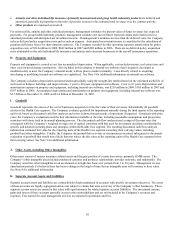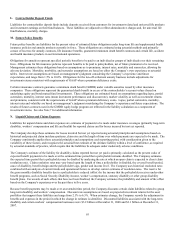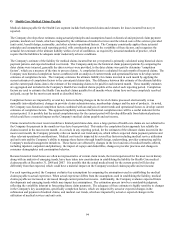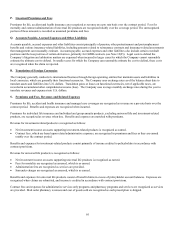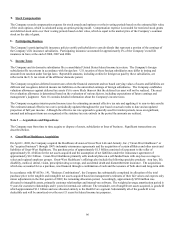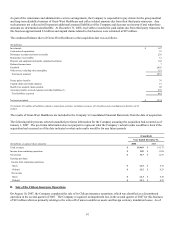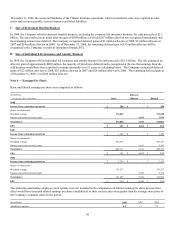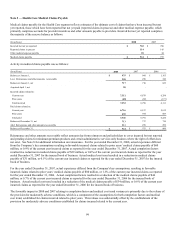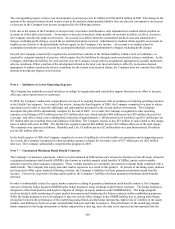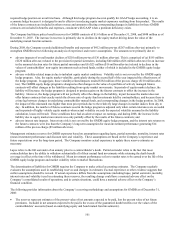Cigna 2008 Annual Report Download - page 111
Download and view the complete annual report
Please find page 111 of the 2008 Cigna annual report below. You can navigate through the pages in the report by either clicking on the pages listed below, or by using the keyword search tool below to find specific information within the annual report.
91
analyses and, in some cases, third party appraisals.
At the time of foreclosure, properties are reclassified from commercial mortgage loans to real estate. The Company rehabilitates, re-
leases and sells foreclosed properties. This process usually takes from 2 to 4 years unless management considers a near-term sale
preferable.
Other long-term investments. Other long-term investments include investments in unconsolidated entities. These entities include
certain limited partnerships and limited liability companies holding real estate, securities or loans. These investments are carried at
cost plus the Company’s ownership percentage of reported income or loss in cases where the Company has significant influence,
otherwise the investment is carried at cost. Also included in other long-term investments are loans to unconsolidated real estate
entities secured by the equity interests of these real estate entities, which are carried at unpaid principal balances (mezzanine loans).
Additionally, other long-term investments include interest rate and foreign currency swaps carried at fair value. See Note 12(F) for
information on the Company’s accounting policies for these derivative financial instruments.
Short-term investments. Investments with maturities of less than one year from time of purchase are classified as short-term, available
for sale and carried at fair value, which approximates cost.
Derivative financial instruments. Note 12(F) discusses the Company’s accounting policies for derivative financial instruments.
Net investment income. When interest and principal payments on investments are current, the Company recognizes interest income
when it is earned. The Company stops recognizing interest income when interest payments are delinquent or when certain terms
(interest rate or maturity date) of the investment have been restructured. Net investment income on these investments is only
recognized when interest payments are actually received. Interest and dividends earned on trading and hybrid securities are included
in net investment income.
Investment gains and losses. Realized investment gains and losses result from sales, investment asset write-downs, changes in the
fair values of trading and hybrid securities and certain derivatives and changes in valuation reserves, based on specifically identified
assets. Realized investment gains and losses on the disposition of certain directly owned real estate investments are eliminated from
ongoing operations and reported in discontinued operations when the operations and cash flows of the underlying assets are clearly
distinguishable and the Company has no significant continuing involvement in their operations.
Unrealized gains and losses on fixed maturities and equity securities carried at fair value (excluding trading and hybrid securities) and
certain derivatives are included in accumulated other comprehensive income (loss), net of:
• amounts required to adjust future policy benefits for run-off settlement annuity business; and
• deferred income taxes.
E. Cash and Cash Equivalents
Cash equivalents consist of short-term investments with maturities of three months or less from the time of purchase that are classified
as held to maturity and carried at amortized cost. The Company reclassifies cash overdraft positions to “accounts payable, accrued
expenses and other liabilities” when the legal right of offset does not exist.
F. Premiums, Accounts and Notes Receivable and Reinsurance Recoverables
Premiums, accounts and notes receivable are reported net of an allowance for doubtful accounts of $50 million as of December 31,
2008 and $54 million as of December 31, 2007. Reinsurance recoverables are estimates of amounts that the Company will receive
from reinsurers and are recorded net of an allowance for unrecoverable reinsurance of $23 million as of December 31, 2008 and $27
million as of December 31, 2007.
G. Deferred Policy Acquisition Costs
Acquisition costs include sales compensation, commissions, premium taxes and other costs that the Company incurs in connection
with new and renewal business. Depending on the product line they relate to, the Company records acquisition costs in different
ways. Acquisition costs for:
• Universal life products are deferred and amortized in proportion to the present value of total estimated gross profits over the
expected lives of the contracts.





